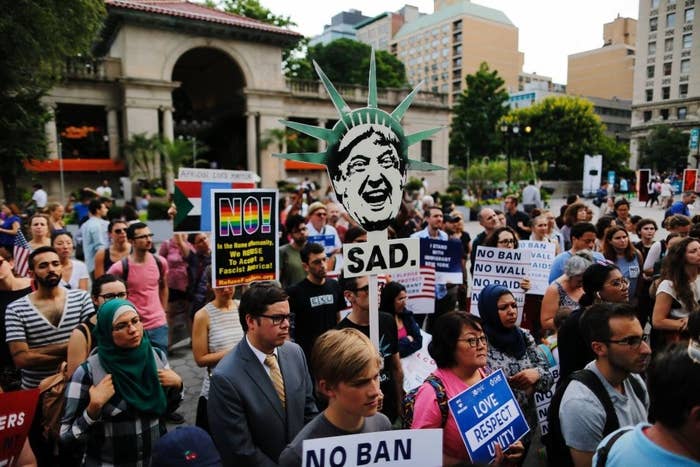
The Trump administration believes its tax-slashing policy agenda would boost growth far above what many economists project over the next decade, but that growth may be harder to come by if it restricts immigration as more people retire.
There is a near-ironclad consensus across the political spectrum that more immigration increases the size of the overall economy. "There’s no question that adding more people, even poor people, increases the size of the GDP," Steven Camarota, the director of research at the Center for Immigration Studies, a group that supports restricting immigration, told BuzzFeed News.
Two conservative Republican senators, Arkansas' Tom Cotton and Georgia's David Perdue, are working on a proposal that would decrease legal immigration by 50% in 10 years so that about 500,000 immigrants arrive in the US each year as opposed to 1 million. Politico reported that they are working on the plan with White House adviser Stephen Miller.
"Of all the policies where we looked at growth effects, probably the biggest single driver of growth right now would be immigration," Maya MacGuineas, the president of the nonprofit Committee for a Responsible Federal Budget, told BuzzFeed News. "If you’re trying to cobble together a growth plan...immigration has a lot of appeal."
The connection between immigration and growth is straightforward: When you have more people in the country spending money, the economy expands. The expansion of the workforce and increases in productivity — meaning more output per hour worked or dollar of capital invested — make up economic growth.
While there is a big debate in the economics community over how mass immigration affects low-wage workers, there is almost no debate on whether it adds to the aggregate size of the economy.
Citing the work of Harvard immigration economist Geroge Borjas, Camarota said the benefits of the "surplus" brought on by immigrants mostly go to consumers who buy cheaper goods and investors. Meanwhile, he said, low-wage workers who compete with immigrants are put at a disadvantage, a point that other economists dispute.
In a statement to Politico, Cotton's spokesperson Caroline Rabbitt leaned heavily on the argument that the current immigration system disadvantages people with low wages and less education. "Sen. Cotton knows that being more deliberate about who we let into our country will raise working-class wages...He and Sen. Perdue are working with President Trump to fix our immigration system so that instead of undercutting American workers, it will support them and their livelihoods."
Spokespeople for Cotton and Perdue did not respond to a request for comment.
No matter who gains from immigration, economists agree that a plan that would drastically slash the number of new immigrants makes Trump's promises of faster economic growth much more difficult to achieve, particularly as the boomer generation retires.
The White House is currently in a dispute with the Congressional Budget Office over how much the American economy can grow over the next 10 years. The CBO projects the average growth rate over the next decade will be 1.8%. The executive branch's Office of Management and Budget says that it will rise to 3% in the second half of the decade thanks to the White House's policy agenda.
The administration is relying on its optimistic growth projections to get its budget to balance in 10 years. If the economy is growing faster, tax collections can stay high and make up the deficit gap left by the lower tax rates the Trump administration is proposing alongside substantial new military spending.
Yet the CBO estimated that the Trump budget proposals would reduce the deficit by much less than the White House claims, and that "nearly all of that difference arises because the Administration projects higher revenue collections—stemming mainly from a projection of faster economic growth," the CBO said.
Isaac Shaprio, a senior fellow at the progressive Center on Budget and Policy Priorities, told BuzzFeed News that the administration's economic projections are "unprecedentedly optimistic."
While it's not unheard of for the White House to have a more optimistic estimate of how quickly the economy will grow, "this large a gap between an administration’s growth forecast and CBO’s is unprecedented," Chad Stone, the chief economist at the Center on Budget and Policy Priorities, wrote in a report. Neither the Bush nor Obama administration had more than a 0.4 percentage points discrepancy between their growth projections and the CBO's.
Even if the Trump administration was able to implement a bunch of pro-growth policies, it would still have to struggle with stubborn demographic facts. The working age population is set to shrink, not grow — which could be mitigated by more immigration. The CBO estimates that the labor force will grow less than 1% a year over the next decade as baby boomers retire in large numbers. The CRFB estimates that the growth in the labor force will only add a quarter as much as the growth rate as it has historically.
"The slower the labor force growth is, than the greater the productivity miracle would have to be," Shapiro said.
In a Wall Street Journal column Thursday, OMB director Mick Mulvaney said the president’s broad agenda, now branded "MAGAnomics" can "set the stage for the greatest revival of the American economy since the early 1980s."
He argued that productivity would get a boost from tax cuts, infrastructure spending, and new trade deals, while the labor force would expand if welfare programs were changed to encourage their recipients to work more.
Mulvaney did not mention immigration at all. Yet the CRFB found that immigration reform like the one proposed in 2013 would increase GDP growth by three-tenths of a percent, making up almost 30% of the gap between consensus growth and what the Trump administration hopes.
Conservative economist Doug Holtz-Eakin organized a letter signed by nearly 1,500 economists supporting "our broad consensus that immigration is one of America’s significant competitive advantages in the global economy."
The Office of Management and Budget did not respond to a request for comment.
